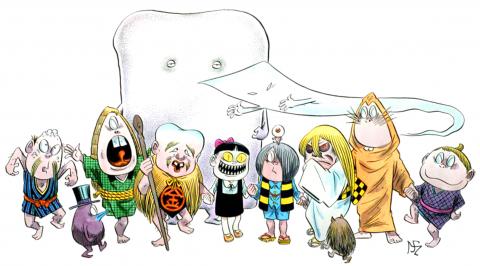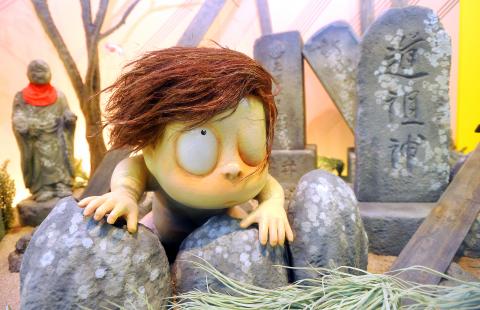GeGeGe no Kitaro fans will be able step into the world of the popular Japanese manga series at Huashan 1914 Creative Park (華山1914) until April 29. GeGeGe no Kitaro’s Yokai Paradise (鬼太郎之妖怪樂園) uses multimedia to bring artist Shigeru Mizuki’s yokai, or monsters from Japanese folklore, to life.
A household name in Japan, Mizuki also enjoys a large and devoted fan base in Taiwan. Created in 1959, GeGeGe no Kitaro revolves around the adventures of Kitaro, a half-human, half-yokai boy, as he maneuvers between his two worlds. The manga is known for its wacky sense of humor and detailed illustrations.
Born in 1922, Mizuki began entering oil painting competitions as a schoolboy. While serving as a soldier in the World War II, Mizuki lost his left arm, but persevered with his art career after the war, creating comics with science fiction and fantasy themes. Since its first publication five decades ago, GeGeGe no Kitaro has been adapted into cartoon series and films, drawing in fans of all ages.

Photo Courtesy of GeGeGe no Kitaro’s Yokai Paradise
Mizuki’s hometown of Sakiminato is now a tourist attraction with a street dedicated to his creations. GeGeGe no Kitaro Yokai Paradise marks the first time an exhibition of this size dedicated to the manga has been held outside of Japan.
“We want to create something that will allow Taiwanese viewers to experience the world of yokai for themselves,” says organizer Wu Chia-fang (吳嘉芳).
Huashan 1914 Creative Park, which is housed in a former wine factory, was chosen as the event’s venue because of its atmosphere. GeGeGe no Kitaro’s Yokai Paradise is divided into eight spaces, each with its own theme. Forest spirits have their own space, as does a “yokai city plaza” where visitors can take photos with their favorite ghosts and monsters. A gallery will introduce the manga’s spooky but fun world to curious visitors.

Photo Courtesy of GeGeGe no Kitaro’s Yokai Paradise
All scenery and creatures were specially crafted for the event. Wu says that her team spent almost a year planning GeGeGe no Kitaro’s Yokai Paradise and have been working at Huashan 1914 Creative Park since
the end of November to create the elaborate, interactive displays.
A store will sell hard-to-find GeGeGe no Kitaro merchandise for diehard collectors. Items include figures, stuffed toys and T-shirts.

On April 26, The Lancet published a letter from two doctors at Taichung-based China Medical University Hospital (CMUH) warning that “Taiwan’s Health Care System is on the Brink of Collapse.” The authors said that “Years of policy inaction and mismanagement of resources have led to the National Health Insurance system operating under unsustainable conditions.” The pushback was immediate. Errors in the paper were quickly identified and publicized, to discredit the authors (the hospital apologized). CNA reported that CMUH said the letter described Taiwan in 2021 as having 62 nurses per 10,000 people, when the correct number was 78 nurses per 10,000

May 5 to May 11 What started out as friction between Taiwanese students at Taichung First High School and a Japanese head cook escalated dramatically over the first two weeks of May 1927. It began on April 30 when the cook’s wife knew that lotus starch used in that night’s dinner had rat feces in it, but failed to inform staff until the meal was already prepared. The students believed that her silence was intentional, and filed a complaint. The school’s Japanese administrators sided with the cook’s family, dismissing the students as troublemakers and clamping down on their freedoms — with

As Donald Trump’s executive order in March led to the shuttering of Voice of America (VOA) — the global broadcaster whose roots date back to the fight against Nazi propaganda — he quickly attracted support from figures not used to aligning themselves with any US administration. Trump had ordered the US Agency for Global Media, the federal agency that funds VOA and other groups promoting independent journalism overseas, to be “eliminated to the maximum extent consistent with applicable law.” The decision suddenly halted programming in 49 languages to more than 425 million people. In Moscow, Margarita Simonyan, the hardline editor-in-chief of the

Six weeks before I embarked on a research mission in Kyoto, I was sitting alone at a bar counter in Melbourne. Next to me, a woman was bragging loudly to a friend: She, too, was heading to Kyoto, I quickly discerned. Except her trip was in four months. And she’d just pulled an all-nighter booking restaurant reservations. As I snooped on the conversation, I broke out in a sweat, panicking because I’d yet to secure a single table. Then I remembered: Eating well in Japan is absolutely not something to lose sleep over. It’s true that the best-known institutions book up faster